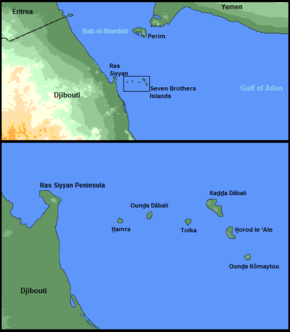Seven Brothers Islands
 | |
 | |
| Geography | |
|---|---|
| Location | Bab-el-Mandeb |
| Coordinates | 12°27′46″N 43°24′06″E / 12.46278°N 43.40167°E |
| Total islands | 6 |
| Area | 1.02 km2 (0.39 sq mi) |
| Highest elevation | 114 m (374 ft) |
| Administration | |
| Region | Obock |
The Seven Brothers Islands, also known as the Sawabi Islands or Seba Islands, is an archipelago in the Dact-el-Mayun section of the Bab-el-Mandeb strait (between the Red Sea and the Gulf of Aden). They are within the Obock District of Djibouti, and are a notable diving site.[1] Even in English publications, the group is often called by its French name, Sept Frères.
Geography[edit]
The archipelago proper is a chain of six volcanic islands spanning about 10 kilometres (6.2 mi) in a rough east-west line:[2]
- West Island, or Red Island (H̱amra), 62 m high
- Double Island (Ounḏa Dâbali), 46 m high
- Low Island (Tolka), 17 m high
- Big Island (Kaḏḏa Dâbali), 114 m high
- East Island (H̱orod le ‘Ale), 83 m high
- South Island (‘Ounḏa Kômaytou), 47 m high
The "seventh brother" is not an island, but the volcanic hill at the northern tip of the Ras Siyyan peninsula.
West Island lies about 4.5 kilometres (2.8 mi) east from the Siyyan peninsula and 6.0 kilometres (3.7 mi) northeast from the coast of Djibouti.[3]
All the islets are surrounded by reefs. All are brownish, except Big Island which is yellowish.[2] There is a masonry marker on the summit of Big Island.[2]
Climate[edit]
The warmest month of the year is July with an average temperature of 39.0 °C. The archipelago consists of the main island of Kaḏḏa Dâbali, the five smaller islands of Ounḏa Dâbali, H̱amra, Tolka, H̱orod le ‘Ale and Ounḏa Kômaytou, as well as small rock outcrops that are uninhabitable by humans but important for seabirds. The sky is always clear and bright throughout the year. The climate of Seven Brothers Islands is classified in the Köppen climate classification as BWh, meaning a desert climate with a mean annual temperature over 29 °C or 84 °F.
| Climate data for Seven Brothers Islands | |||||||||||||
|---|---|---|---|---|---|---|---|---|---|---|---|---|---|
| Month | Jan | Feb | Mar | Apr | May | Jun | Jul | Aug | Sep | Oct | Nov | Dec | Year |
| Mean daily maximum °C (°F) | 29.8 (85.6) |
29.8 (85.6) |
31.4 (88.5) |
33.2 (91.8) |
35.6 (96.1) |
38.2 (100.8) |
39.0 (102.2) |
38.3 (100.9) |
37.1 (98.8) |
34.4 (93.9) |
31.8 (89.2) |
30.3 (86.5) |
34.1 (93.3) |
| Mean daily minimum °C (°F) | 22.6 (72.7) |
23.4 (74.1) |
24.4 (75.9) |
25.8 (78.4) |
27.9 (82.2) |
30.1 (86.2) |
30.2 (86.4) |
29.4 (84.9) |
29.5 (85.1) |
26.5 (79.7) |
23.8 (74.8) |
22.7 (72.9) |
26.4 (79.4) |
| Average rainfall mm (inches) | 4 (0.2) |
3 (0.1) |
6 (0.2) |
4 (0.2) |
1 (0.0) |
0 (0) |
5 (0.2) |
6 (0.2) |
12 (0.5) |
4 (0.2) |
4 (0.2) |
4 (0.2) |
53 (2.2) |
| Source: World Weather | |||||||||||||
References[edit]
- ^ Alwan, Daoud Aboubaker; Mibrathu, Yohanis (2000). Historical dictionary of Djibouti. Scarecrow Press. pp. 47–. ISBN 978-0-8108-3873-4. Retrieved 28 May 2011.
- ^ a b c Sailing Directions (Enroute) - Red Sea and Persian Gulf, page 162. National Geospatial Intelligence Agency pub. 172. Accessed 2012-07-6.
- ^ Dzurek, Daniel J.; University of Durham. International Boundaries Research Unit (2001). Parting the Red Sea: boundaries, offshore resources and transit. IBRU. pp. 8–. ISBN 978-1-897643-46-4. Retrieved 28 May 2011.
12°27′38″N 43°25′27″E / 12.4606°N 43.4242°E
